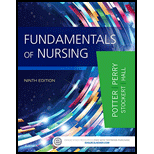
Concept explainers
To determine:
She has recently begun pelvic muscle exercise (Kegel) and bladder retraining. She shares her concern that the exercise is not working and that she is still wet multiple times a day. Which additional teaching does Mrs. Grayson need.
Case summary:
Mrs. Grayson is a 75-year-old woman has had problems with urge incontinence for the past 2 years. She has not spoken to anyone about her problems because she is embarrassed. She finally confides to her health care practitioner that the problem is causing her to avoid social situations and she would like to regain urinary control. Mrs. Grayson has type 2 diabetes and is obese. She has been referred to a continence specialist. A plan of care was developed after a thorough assessment of her urinary pattern and symptoms.
Explanation of Solution
Urinary incontinence is an embarrassing problem in which the urinary bladder lost its control. It results in intense, sudden urine urgency and leads to involuntary control of urine. This condition might result by diabetes mellitus, infection, and in neurologic disorder.
Bladder retraining program is a behavior therapy which helps to treat urinary incontinence. This program uses to increase the time between bladder emptying.
Kegel exercise is also called as pelvic muscle exercise which is consists of relaxing and contracting the pelvic muscles. During exercise, relaxed breathing and tightening the stomach, thigh muscles are needed simultaneously. Increase the squeezes for every week and avoid overdoing it. Rest is needed between each set of squeezes that gives a better result.
Mrs. Grayson is encouraged to do exercise regularly as per the continence specialist. It gives results after 4 weeks of steady exercise. She is continuously observed by the continence specialist that she could do the exercise properly as continence specialist instruction. If the patient has any problems in doing correct exercise or identifying the correct muscles, she is back to the continence specialist.
Mrs. Grayson is needed to encourage to do exercise consistently, only after 4 weeks it gives best results. She is advised to do the exercise properly as the instruction of the continence specialist.
Want to see more full solutions like this?
Chapter 46 Solutions
Fundamentals of Nursing, 9e
- explain an abdominal exam?arrow_forwardDiscuss β -Lactam antibiotics under the following subheadings Classifications of penicillins Classification of Cephalosporins General Mechanism of Actions Clinical Indications of penicillins and cephalosporins Adverse effects of β-lactamsarrow_forwarda. Define neoplasm b. Differentiate between benign and malignant tumours c. Describe the molecular basis of cancerarrow_forward
- differentiate the extra heart sounds S3,S4, murmurs and gallopsarrow_forward• Define shock and list types of shock • Discuss pathogenesis of septic shock. • Enumerate the stages of shock. • Define oedema and describe the pathophysiologic mechanisms of oedema with examples.arrow_forwardDiscuss Hypertension under the following headings: Definition Diagnosis Non-pharmacological intervention Drugs Classification Management of a Hypertensive emergencyarrow_forward
- Explain how the answer could be 2 or 1.8 WITHOUT changing the questionarrow_forwardoverview of the neurological system, cranial nerves and what part of the body it innervatesarrow_forwarddifferentiate structure and function of the peripheral vascular system. what are the normal and abnormal findings of the peripheral arterioles and peripheral venous systemarrow_forward
 Phlebotomy EssentialsNursingISBN:9781451194524Author:Ruth McCall, Cathee M. Tankersley MT(ASCP)Publisher:JONES+BARTLETT PUBLISHERS, INC.
Phlebotomy EssentialsNursingISBN:9781451194524Author:Ruth McCall, Cathee M. Tankersley MT(ASCP)Publisher:JONES+BARTLETT PUBLISHERS, INC. Gould's Pathophysiology for the Health Profession...NursingISBN:9780323414425Author:Robert J Hubert BSPublisher:Saunders
Gould's Pathophysiology for the Health Profession...NursingISBN:9780323414425Author:Robert J Hubert BSPublisher:Saunders Fundamentals Of NursingNursingISBN:9781496362179Author:Taylor, Carol (carol R.), LYNN, Pamela (pamela Barbara), Bartlett, Jennifer L.Publisher:Wolters Kluwer,
Fundamentals Of NursingNursingISBN:9781496362179Author:Taylor, Carol (carol R.), LYNN, Pamela (pamela Barbara), Bartlett, Jennifer L.Publisher:Wolters Kluwer, Fundamentals of Nursing, 9eNursingISBN:9780323327404Author:Patricia A. Potter RN MSN PhD FAAN, Anne Griffin Perry RN EdD FAAN, Patricia Stockert RN BSN MS PhD, Amy Hall RN BSN MS PhD CNEPublisher:Elsevier Science
Fundamentals of Nursing, 9eNursingISBN:9780323327404Author:Patricia A. Potter RN MSN PhD FAAN, Anne Griffin Perry RN EdD FAAN, Patricia Stockert RN BSN MS PhD, Amy Hall RN BSN MS PhD CNEPublisher:Elsevier Science Study Guide for Gould's Pathophysiology for the H...NursingISBN:9780323414142Author:Hubert BS, Robert J; VanMeter PhD, Karin C.Publisher:Saunders
Study Guide for Gould's Pathophysiology for the H...NursingISBN:9780323414142Author:Hubert BS, Robert J; VanMeter PhD, Karin C.Publisher:Saunders Issues and Ethics in the Helping Professions (Min...NursingISBN:9781337406291Author:Gerald Corey, Marianne Schneider Corey, Cindy CoreyPublisher:Cengage Learning
Issues and Ethics in the Helping Professions (Min...NursingISBN:9781337406291Author:Gerald Corey, Marianne Schneider Corey, Cindy CoreyPublisher:Cengage Learning





